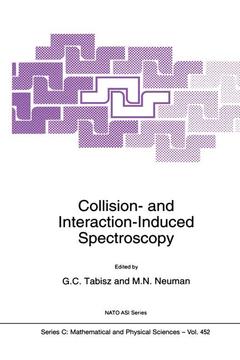Description
Collision- and Interaction-Induced Spectroscopy, 1995
Nato Science Series C: Series, Vol. 452
Coordinators: Tabisz G.C., Neuman Murray N.
Language: English
Subjects for Collision- and Interaction-Induced Spectroscopy:
Keywords
Planet; astrophysics; collision; scattering; spectra; spectroscopy
Publication date: 10-2012
588 p. · 16x24 cm · Paperback
588 p. · 16x24 cm · Paperback
Description
/li>Contents
/li>
Collision-or interaction-induced spectroscopy refers to radiative transitions, which are forbidden in free atoms or molecules, but which occur in clusters of interacting atoms or molecules. The most common phenomena are induced absorption, in the infrared region, and induced light scattering, which involves inelastic scattering of visible laser light. The particle interactions giving rise to the necessary induced dipole moments and polarizabilities are modelled at long range by multipole expansions; at short range, electron overlap and exchange mechanisms come into play. Information on atomic and molecular interactions and dynamics in dense media on a picosecond timescale may be drawn from the spectra. Collision-induced absorption in the infrared was discovered at the University of Toronto in 1949 by Crawford, Welsh and Locke who studied liquid O and N. Through the 1950s and 1960s, 2 2 experimental elucidation of the phenomenon, particularly in gases, continued and theoretical underpinnings were established. In the late 1960s, the related phenomenon of collision-induced light scattering was first observed in compressed inert gases. In 1978, an 'Enrico Fermi' Summer School was held at Varenna, Italy, under the directorship of J. Van Kranendonk. The lectures, there, reviewed activity from the previous two decades, during which the approach to the subject had not changed greatly. In 1983, a highly successful NATO Advanced Research Workshop was held at Bonas, France, under the directorship of G. Birnbaum. An important outcome of that meeting was the demonstration of the maturity and sophistication of current experimental and theoretical techniques.
Cancellation Effects in Collision-Induced Phenomena.- Three-Body CILS Spectra of Gases:.- Irreducible Three-Body Dipole Moments in Hydrogen.- Ternary Effects in Far IR Absorption in the Gas Phase.- Collision-Induced Dipoles and Polarizabilities for S State Atoms or Diatomic Molecules.- Dielectric Properties of Dense Fluids.- Depolarized Light Scattering: The Influence of Induced Scattering on Allowed Raman and Rayleigh Bands.- Moments: Simulation and Theory for Rayleigh and Raman Spectra.- Interaction-Induced Spectral Properties of Small Molecule Dense Fluids by Raman Scattering.- Simulation of the Far Infrared Spectrum of Liquid Water and Steam Along the Coexistence Curve from the Triple Point to the Critical Point.- Interaction-Induced Contributions to Spectra of Polar Liquids.- Kinetic Theory Approach to Interaction Induced Light Scattering.- The Characterisation of Interaction-Induced Vibrational Spectra in Complex Liquids.- Far Infrared Spectroscopic Investigations of Liquid Mixtures.- Theory of Infrared Bandshapes in Hydrogen-Bonded Crystals.- Rayleigh-Brillouin Light Scattering in Supercooled Liquids.- Interaction-Induced Spectra as a Tool for the Study of Structure in Supercooled Liquids and Glasses.- Composition Induced Dynamic Depolarized Light Scattering from Diblock Copolymer Systems Near the Ordering Transition.- Interaction-Induced Spectra of Endohedral Complexes of Buckminsterfullerene.- Electric Field Effects Observed on the Infrared Spectra of Molecules Adsorbed in Zeolites.- Atoms in Irradiated Solid Deuterium: Charge-Induced Spectra.- Induced Light Scattering from Electrically Disordered Solids.- On the Spectroscopy of Solid Hydrogen.- Collisional Redistribution of Light.- Depolarization in Collisionally-Induced Electronic Transitions.- The Depolarized Interaction-Induced Light Scattering Spectrum of Mercury Vapor at Low Density.- Calculation of Far Wings of Allowed Spectra: The Water Continuum.- Calculation of High-Frequency Wings of Interaction-Induced Spectra.- Collision-Induced and Allowed Raman Spectra in Hydrogen Gas.- Interference of Allowed and Collision-Induced Transitions in HD: Experiment.- Interference of Allowed and Collision-Induced Transitions in HD: Calculation.- High-Frequency Interaction-Induced Rototranslational Wings of Molecular Spectra.- Ab Initio Interaction-Induced Dipoles and Related Absorption Spectra.- Far Infrared Absorption Spectra of CO2 with He, Ar and Xe: Experiment and Calculations.- Infrared Studies of van der Waals Complexes: The Low Temperature Limit of Collision-Induced Spectra.- Dimer Features of H2-H2 and Isotopomers at Low Temperatures.- The Pure Translational Spectrum of Low Temperature Hydrogen Gas.- Semiclassical Calculations of Profiles of Induced Spectra.- Induced Spectra in Planetary Atmospheres.- Collision-Induced Molecular Absorption in Stellar Atmospheres.- Workshop Report: Gases.- Workshop Report on Liquids.- Some Reflections at the End of the Workshop.- Author Index.- Chemical Index.
© 2024 LAVOISIER S.A.S.

